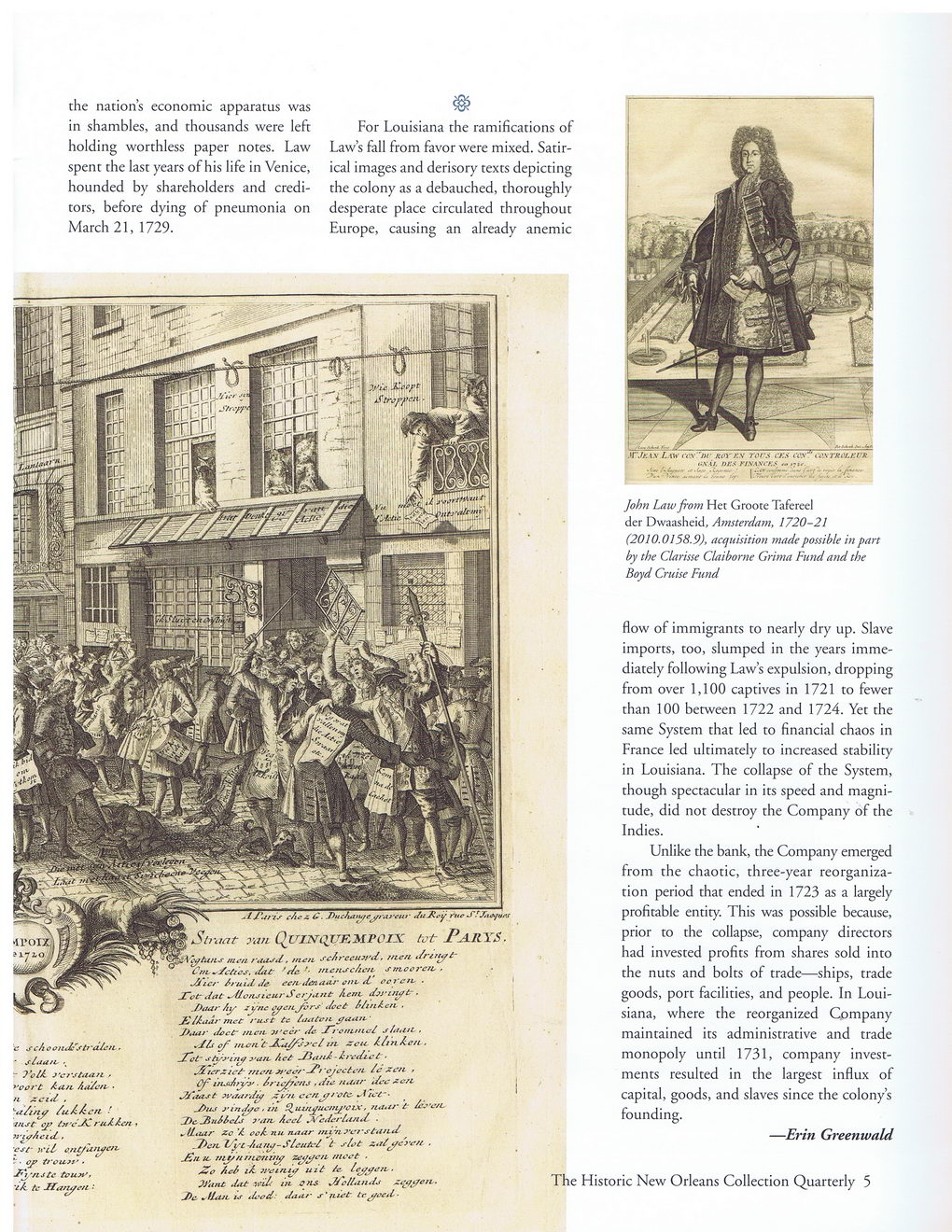This text was obtained via automated optical character recognition.
It has not been edited and may therefore contain several errors.
the nation’s economic apparatus was in shambles, and thousands were left holding worthless paper notes. Law spent the last years of his life in Venice, hounded by shareholders and creditors, before dying of pneumonia on March 21, 1729. For Louisiana the ramifications of Law’s fall from favor were mixed. Satirical images and derisory texts depicting the colony as a debauched, thoroughly desperate place circulated throughout Europe, causing an already anemic .tr./A i.v coy"'])!' /iorr.v Tors cr,s cry1.' Ci\\TH0i.j-:rR. ' r ^ OX.il, DJlS .FIXAVr/-;^ Cf i:ic. John Law from Het Groote Tafereel der Dwaasheid, Amsterdam, 1720-21 (2010.0158.9), acquisition made possible in part by the Clarisse Claiborne Grima Fund and the Boyd Cruise Fund flow of immigrants to nearly dry up. Slave imports, too, slumped in the years immediately following Law’s expulsion, dropping from over 1,100 captives in 1721 to fewer than 100 between 1722 and 1724. Yet the same System that led to financial chaos in France led ultimately to increased stability in Louisiana. The collapse of the System, though spectacular in its speed and magnitude, did not destroy the Company of the Indies. Unlike the bank, the Company emerged from the chaotic, three-year reorganization period that ended in 1723 as a largely profitable entity. This was possible because, prior to the collapse, company directors had invested profits from shares sold into the nuts and bolts of trade—ships, trade goods, port facilities, and people. In Louisiana, where the reorganized Company maintained its administrative and trade monopoly until 1731, company investments resulted in the largest influx of capital, goods, and slaves since the colony’s founding. —Erin Greenwald 'c scho ondfsti 'dden, > * slaatv * ;• I'olA J’cfJtaa.71 > Au7l Ad/e/i- • n xctd , ^u/z/zy /uAkcrt ■ lust oy to'edC rtcA-Ae/i 1 est n'lt ontfuiiyezi, ’■ ■ OJ? • J*2,‘nj£e tvu?ts, i A. ft JTarupe/L • .l£*aris c/ie z C. J>ucJut^eryra.ycur duJZcyrue SfJaaytvs Slwat ran QjJINQJTJZMPOlX tot PJlRYS. A'eyht/Ls me it, raasd, men scfireeizwd, dt £?*y£ Cz/v^-dctzes. datr f de. f- z/lczisc/zc/v sntooz czv > Jficr 6ruid.de. ec/t. dmadr oni, d ocreti* • ' dat ^diortsieuz'Sezyunt /tern- du' tzzyt -d>aar /ty #yen jars' doet blztiAen, . J£ /Jcaar met rust tc Imttezi, efuun* J)aar d^cir men- yt'ccr de J~rcninicl s fauit . „J/j of 1/LC71 Z7L ZCti. &Zl7lA.e/L , Tcf styj'iny yurts Aet -liezzd - Avedie • dii£r2zeJ- ??zefi &'ee,/‘-Z*i'ojectc’/L /c xezi > Of insdiTyry. iriefrens ,dze naar dec xerz. ; Jfaast WtMrdiy zis/i ecziyfotc- *Azcl~- ^ 1 ^Z>ns j’in dye, in Q iiuiyuczzt^’ezx, 7iaur t /cj’c/i-d)c- JiuS&els yan- Aeel J/ederLt/zd • *. ILtiur zo ’A coA nu. rtaur /nyn, J’e/'slutLtd X/yt-/iany-S£eu&'l t s/at ^a/^ye^e/z , dSn it- rtiJ/fzni&Jiuzy zeyyezz, meet , /teb lA weinit? mi Ae. lejfyen,. Want tictt■ in ons Jfctttinds zeyyeiz. J>C. vttatt, is d'ed: dam- s' niet tcyoed ■ The Historic New Orleans Collection Quarterly 5

New Orleans Quarterly 2011 Fall (05)